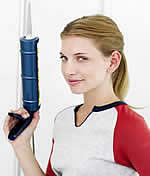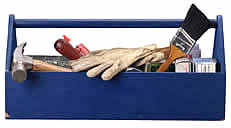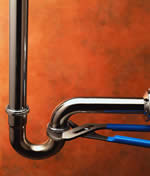THE FIRST STEP IS TO "LET GO"
When talking with your real estate agent, you may find if you are a buyer they will refer to the potential purchase as a "home." But if you are selling, they will often refer to the property as a "house." They have a good reason for doing this. Buying a new home is often an emotional decision, but when you are selling you need to remove emotion from the situation. You need to think of the house you are trying to sell in terms of "real estate", "property", or a "marketable commodity". Your goal is to help buyers see it as their home, not yours. This can be especially difficult if you are selling a beloved home where you've spent many happy years raising your family or if you are selling your elderly or deceased parents' home where you grew up yourself. However, if you don't make a conscious decision to be objective and detached, you may unwittingly create an atmosphere where it takes longer to sell.
Toward that end you will need to de-personalize your home. Remove all personal items from your house such as family photos, sports trophies, college banners, and collectables. Store them in another location if at all possible so that you don't clutter the attic, basement, or storage areas. If you have an opportunity to do so, visit a "model home" in a new housing development in your area. You will see sparsely but tastefully decorated rooms throughout. You don't need to make the rooms as bland as a motel, but keep decorations neutral and to a minimum. Help potential buyers feel drawn to attractive rooms which they can envision making their own.
IS YOUR HOME PHYSICALLY FIT?

To give your house a competitive edge when it's time to sell, make sure it is in good physical condition. This not only makes your house more attractive and desirable, it also simplifies the negotiation process when the time comes for the buyer's pre--purchase inspection.
According to home inspection experts, approximately half of the resale homes on the market today have at least one significant defect. Routine maintenance is the best way to prevent major costly problems from developing in the first place. So if you've been putting off repairs, now is the time to make them. As an added plus, you may receive a tax benefit for fixing up your house before you sell. According to the American Institute of Certified Public Accounts, money spent on repairs made during the 90-day period prior to contract may reduce your taxable capital gain.
GETTING HELP
To identify which components are most in need of repair, many sellers now commission Pre-Listing Home Inspections before putting up the "For Sale" sign. The person best qualified to do this is an experienced professional home inspector. Choose an inspection firm that employs only those certified by ASHI®, the American Society of Home Inspectors®. ASHI® is the leading national professional organization of independent home inspectors and is the recognized authority in this field. ASHI® sets the highest standards for its members and requires its members to adhere to a strict code of ethics.
A SELLER'S CHECKLIST

There are certain problems that typically appear on a buyer's' home inspection report. Early correction of these problems can increase your home's appeal and its selling price. It also sets the stage for a favorable home inspection report for the buyer thereby helping to expedite the sale. The following 6-point checklist can help you achieve these marketing goals:
1. CHECK THE MAJOR SYSTEMS. After size, style, and location, a home buyer's primary concern is the condition of the home's basic structure and major systems. Most buyers do not want to invest a great deal of money correcting problems in critical areas. A pre-listing home inspection can reveal problems and include recommendations for repairs, if needed, on the major items/areas such as the roof, the exterior and interior structure, the electric system, heating and cooling, plumbing, etc.
2. MAKE MAINTENANCE IMPROVEMENTS. A number of maintenance improvements are relatively easy and inexpensive to make, yet they can substantially improve a home's appearance, efficiency and comfort. Pay attention to details. Fixing even minor items can go a long way toward improving that important first impression. Here are some typical improvements which might be suggested by the home inspector's findings:
  
- Apply new caulking and weather-stripping as needed around windows and doors.
- Clean gutters of debris and leaves for proper drainage.
- Repair or replace cracked or broken gutters, downspouts and extensions.
- Replace bathroom caulk or grouting if needed to prevent seepage and improve appearance.
- Repair leaky faucets.
- Trim trees and shrubs which touch or overhang the house.
- Ventilate basements and crawl spaces or install a dehumidifier to prevent moisture build-up.
- Re-grade soil around the foundation, as needed, to keep water away from the house.
- Replace dirty filters in the heating and air conditioning systems.
- Have the heating and air conditioning systems professionally serviced.
- Have chimneys professionally cleaned, and install chimney hoods or caps as needed.
- Tighten loose doorknobs
- Replace damaged screens
- Replace broken panes of glass
- Replace burned-out light bulbs
- Secure loose railings
- Repair and coat driveway
- Repair peeling wallpaper.
- Patch holes or cracks in walls and ceilings, then repaint.
- Repaint exterior walls and trim, interior walls and trim, and baseboards if dull or chipped.
- A new coat of paint does wonders. Neutral colors such as warm tan, cream, taupe, sage, or a soft white are good choices. You may love bright purple walls, but will most buyers?
The exception to neutral colors is the exterior front door. Choose a rich, welcoming color such as red, black, or chocolate brown that coordinates with the rest of the exterior.
4. TAKE SAFETY PRECAUTIONS: Home inspectors also pay attention to items relating to protecting the home and its occupants from danger. They can alert you to important safety precautions that home buyers will appreciate, such as:

- Install smoke detectors and carbon monoxide detectors on each level of the house.
-
Install Ground Fault Circuit Interrupters (GFCIs) in "wet" areas such as bathrooms, kitchens and outside.
-
Keeping flammable products away from furnaces, water heaters and fireplaces.
- Remove and/or sweep debris off steps and walkways.
-
Keep basement, attic, and garage areas clear and uncluttered to give buyers and home inspectors access to the heating system, electrical equipment, and visible structure.
-
If it is wintertime, keep sidewalks and driveway clear.
5. MAKE COSMETIC IMPROVEMENTS INSIDE OF THE HOUSE:
  
- An attractive, clean, and neat appearance will enhance your home's appeal, so k eep your house tidy. Pick up clutter and put it away. If possible discard items you don't need or store them out of the house. Buyers will look in closets, under beds, and in drawers. If these areas are cluttered, buyers will think the house lacks storage space.
- Beware of pet odors. Clean cat litter boxes daily and replace old litter with fresh regularly. Have only fresh water dishes available for your pet, and remove and wash food dishes as soon as your pet has finished eating. If possible, have a friend take "Fido" or "Bootsie" for a visit during an open house or house showing. You don't want to mislead buyers about your pet ownership, but you don't want to overwhelm them with your pet's presence either. Remember, you may love your pet but not everyone else will feel the same way.
- Open window shades and curtains to create a bright, inviting atmosphere, but make sure you keep all window glass and sills clean.
- Keep furniture to a minimum. Once your house goes on the market, it's not about you and your comfort anymore. Too much furniture or pieces that are overly large shrink a room. If necessary, store extra furniture at another location.
- Use bright bulbs in lamps and light fixtures. Create ambiance and highlight interesting features with spotlights on crown moldings, leaded glass, antique fireplace mantles, etc.
- Houses that sparkle sell. The effort you put into cleaning ceiling fans, doorknobs, baseboards, stains on carpets, cobwebs, etc. will pay off.
- Pay special attention to keeping the kitchen and bathrooms clutter free and clean since buyers will closely scrutinize these areas.
- Create the look of more space on your kitchen countertop by keeping only a few impersonal items on it.
- Keep fresh flowers or an attractive bowl of fresh fruit, such as lemons, on the table.
- Keep wastebaskets clean, empty, and if possible out of sight.
- Buy fresh towels for the bathroom, keep toilets flushed with the lid down, and put out fresh bars of soap and full rolls of toilet paper.
- New throw blankets or pillows can give older furniture and thus an entire room an updated and inviting look.
- Light scented candles when you know your house is about to be shown, but choose "homey" scents such as cinnamon apples, vanilla, or clean linen.
- Keep windows open, weather permitting, to keep house smelling fresh.
6. MAKE COSMETIC IMPROVEMENTS OUTSIDE OF THE HOUSE:
  
- Keep the lawn mowed and trimmed.
- Trim overgrown shrubbery especially in the front yard, along walkways, and by entrance doors.
- Bring mail and newspapers inside.
- As noted in step 2 above, If your front door is drab, paint it a cheery and welcoming color.
- Plant flowers. A flat of annuals, such as marigolds or petunias, is an inexpensive and quick way to add color and curb appeal to your house, and they keep their color from late spring to early fall. Pots of bright geraniums or colorful hanging baskets are a pretty alternative to planted flowers.
- Keep yard free of animal waste.
- Porches and decks can be very welcoming and homey. Keep yours clean, free of clutter, and tastefully decorated with a potted plant or attractive outdoor furniture.
- Keep outdoor spotlights lit into the evening hours to light up a well-manicured front lawn.
- Clean the exterior walls and trim if dull or dirty.
- A driveway with multiple vehicles looks crowded and small. If possible, park extra vehicles in your neighbor's driveway or down the street.
- Walk across the street and take a cold, hard look at your house. Your eyes should be drawn to neatly cut grass and an inviting front door. If they are drawn to a drooping rain gutter or ankle deep weeds, take the necessary steps to fix the problems.
7. PREPARE FOR THE BUYER'S INSPECTION. It's a good idea to assemble in advance various house records that can be used to answer questions from buyers and home inspectors. Specifically, you should have on hand:

- Information on the age of major components such as the furnace, air conditioning unit, and roof.
- Major component warranties (e.g. carpeting, siding, roof shingles, driveway finishing).
- Heating, electrical, and other utilitiy bills from the previous year.
- Appliance receipts, service records and warranties.
- If you had a Pre-Listing Home Inspection performed on your home, have a copy to show potential buyers.
|